author: Kevin Curran
updated: 4-13-2020
What are Chaga mushrooms?
Chaga mushrooms are a fungus that grows on hardwood trees in cold, northern forests.
In the past few years, I’ve seen a resurgence of interest in Chaga mushrooms as a health supplement. Each winter brings a spike in internet traffic from an audience eager to learn more about this mushroom. However, its health benefits are nothing new, indigenous Siberians have been using Chaga for thousands of years.
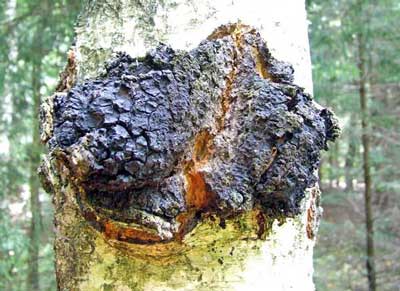
Chaga mushroom growing on a birch tree in Lithuania.
In this article, I summarize the history of Chaga usage and explore the biological basis for the health benefits of Chaga mushrooms.
At the end of this article…
- I describe how to brew your own chaga tea.
- I then review recommended brands of Chaga tea and tinctures.
- On a separate page, I describe my daily plant powder drink.
To jump straight to those sections, click on the links above.
Chaga, or its scientific name: Inonotus obliquus, lives predominantly in the cold Taiga forests. You can find this lumpy, charcoal-colored mushroom growing along the northern latitudes of Russia, Scandinavia, Korea, Japan, U.S. and Canada.*
But don’t look on the ground for Chaga, because this mushroom grows along the sides of birch trees (see photo above) and a few other deciduous hardwoods. When trees lose branches or suffer damage from storms, the Chaga mushroom will grow over the wound to serve as a protective scar. At this point, the dark hyphal mass of Chaga, known as a sclerotia, intertwines with the tree to form a unique fungal/tree interaction. The birch tree can continue living for many years while mounds of Chaga fungus adorn its trunk. This odd, mutualistic relationship allows Chaga collectors to harvest these mushrooms repeatedly from the same birch tree trunk. When Chaga is harvested, the mushroom has the appearance of a burly, flattened mound of charcoal.
Cultural history of the Chaga
Russians and Scandinavians have known about Chaga’s health benefits for quite a long time. In fact, the word ‘Chaga‘ is derived from ‘чага‘, which is the old Russian word for mushroom. This hard to pronounce Russian word, ‘чага‘ stems from Komi-Permyak, which is the language of the indigenous people living near the Ural Mountains. These Native Russians, as well as the Siberian Khanty people (see photo) were supposedly the first people to enjoy the health benefits of the Chaga mushroom.

Khanty people along the Ob river. This indigenous group from Siberia used Chaga mushrooms in the 16th century.
Later on, in the 12th century, Tsar Valdimir Monomakh, also known as the Grand Prince of Kievan Rus, was widely known as a Chaga enthusiast. Apparently, this ancient Russian leader used these mushrooms to cure his lip cancer (2).
During the 16-17th century, the healing powers of Chaga became more formally recognized in medicinal texts. The mushroom appears multiple times in the traditional folk medicine books of Russia and northern Europe. These ancient texts describe the use of Chaga to treat cancer, gastritis, ulcers, and tuberculosis (Kim, 2007, Saar, 1991)
More recently, in the 1950s, Alexander Solzhenitsyn, the famed Russian author and Nobel laureate, became fascinated with Chaga benefits while performing research for one of his books. His novel, Cancer Ward, references the healing properties of Chaga mushrooms.
He could not imagine any greater joy than to go away into the woods for months on end, to break off this chaga, crumble it, boil it up on a campfire, drink it and get well like an animal.
~Alexander Solzhenitsyn, Cancer Ward (1968)

Tsar Vladimir Monomakh rests after boar hunting in a northern birch forest.
Well, Chaga is no longer a folk medicine known only to the Russians. Since Alexander Solzhenitsyn published Cancer Ward, more than 1,600 scientific research papers have investigated the health benefits associated with Chaga (3).
What began as a biological oddity in the northern forests has now become a widely respected super-food for health conscious folks all across the globe.
At this point in the article, you might be wondering about the flavor of Chaga.
Well, fortunately, Chaga tastes much better than it looks. When broken up and mixed in a tea, the mushroom has a pleasant, earthy taste with hints of vanilla.
Most people enjoy the Chaga flavor – but if its too earthy for you, add some honey.
In the next section I’ll walk you through the biological basis for the benefits of Chaga mushrooms.
The biology behind the health benefits of Chaga mushrooms
I often get asked the following question:
Why would a chemical produced in a mushroom have a beneficial effect on the human body?
This is a valid question.
In theory, a mushroom should only invest energy into building internal machinery (chemicals) that will enhance its own chance of survival.
Mushrooms don’t care about human health and survival. Mushrooms care about mushroom survival. So…why would mushrooms build chemicals that help humans?
Well, the thing is, humans actually have a lot in common with mushrooms. There’s quite a bit of overlap in their struggle for survival and our struggle for survival.
For example, both mushrooms and mammals need to constantly defend themselves against bacteria infections. One way a mushroom will defend against bacteria is by producing chemicals that kill bacteria.
Then, when we eat that mushroom, their bacteria-killing chemicals move into our body.
This helps us out.
The chemical – that was produced by a mushroom – is now fending off bacterial infections in our human body.
This is the exact reason why humans take penicillin when we get sick.
Penicillin is a chemical that is naturally produced in a mushroom called Penicillium chrysogenum. This mushroom produces penicillin to defend itself against bacteria. When we eat this chemical, it does the same job in our body.
Since its popularization in the 1940s, penicillin has helped save an estimated 200 million human lives from bacteria infection.
In conclusion…
Yes, humans can enhance their health by eating mushrooms.
Okay, now let’s think specifically about Chaga mushrooms…
Chaga do not have an easy life. Their struggle for survival is especially intense.
They grow in extremely cold forests where they’re exposed to freezing temperatures, snow and ice. Their summers are very hot, which means they experience lots of UV radiation. Most importantly, they are constantly in competition with lots of tiny and dangerous creatures (bacteria, worms, fungus, ext.)
To defend against all of these environmental threats, the Chaga mushroom packs itself full with biologically active chemicals. These chemicals allow the Chaga to compete with other microbial creatures and survive harsh winters.
Here are a few of the chemicals produced by Chaga that are also biologically active in humans.
- Melanin
- Antioxidant enzymes
- Triterpenoids
- Ergosterols
- Sesquiterpenes
- Betulinic acid
- Polysaccharides
- Phytosterols
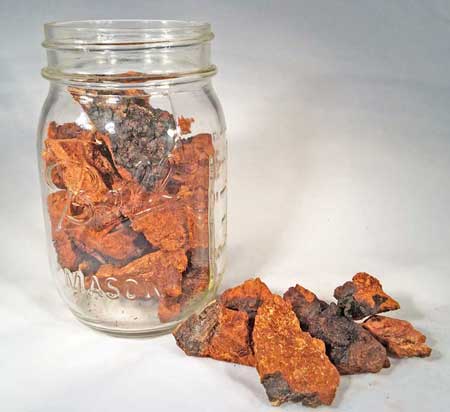
Chunks of Chaga mushroom ready for tea preparation
Multiple laboratory and animal studies explore the ability of these biologically active Chaga chemicals to exert a beneficial effect on mammalian physiology (1).
Published reports explore the ability of Chaga mushrooms to:
- kill cancer cells (Glamočlija, 2015; Ning, 2014; Lee 2009; Baek, 2018; Kang, 2015, Kim 2018)
- reduce damaging inflammation (Mishra, 2012)
- boost the immune system (Ko, 2011; Park, 2005
- relieve pain (Park, 2005)
- increase stamina/reduce fatigue (Yue, 2015)
- act as an antioxidant (Najafzadeh, 2007; Giridharan 2011)
It should be noted that none of the reports above were performed on human patients. These in vitro and animal studies are intriguing, however, clinical studies are needed to confirm their findings.
2020 update: In vitro research has been published demonstrating the ability of Chaga extract to interfere with cancer cells. A study in the Phytomedicine journal indicates that a chemical compound present in Chaga, called Inotodiol, possesses anti-cancer capacity. Using cell culture assays, the authors demonstrate Inotodiol can prevent malignant tumor migration and invasion. Further testing in human subjects could inform us whether Chaga extracts may act as a viable treatment for human cervical cancer.
Inotodiol notably induced tumor cell apoptosis by Annexin-V-FITC apoptosis assay, which is associated with activation pro-apoptotic proteins of PARP, cleaved caspase-3 and Bax expression, inhibition anti-apoptotic protein Bcl-2 expression. ~ Zhang Sun-Dong
Let me decode this quote above….Inotodiol can help cancer cells kill themselves via the apoptotic pathway. This is good. We want the cancer cells in our body to eliminate themselves before they begin to spread throughout the body. It should be repeated that these experiments are currently performed in a dish in a laboratory. We need to see these results repeat in animal models and, ultimately, in human patients before we consider Chaga effective for human cancer.
Below, we will explore other chaga health benefits that have been explored by scientists.
Chaga benefits the human immune system
Both laboratory and animal model experiments demonstrate that Chaga mushrooms can activate the human immune system (1).
In 2011, a group of Korean scientists published a report documenting the changes in activity of human immune cells after exposure to Chaga extract (Ko, 2011). Specifically, they saw significant changes in Th1 and Th2 cytokine secretion levels from immune cells in the spleen of a mouse. Cytokines are the chemical messengers of our immune system. This shift in cytokines then altered the production of antigen-specific antibody producing cells. The production of antibodies is a key component to a fully functional immune system.
Chaga tea benefits: antioxidants protect against oxidative damage.
First some back background on oxidative damage.
Free radicals can cause oxidative damage. A free radical is any molecule that has an unpaired electron in its outer shell. These free radicals bounce around the cells in our body and can cause damage to other molecules, such as our DNA (Hekimi, 2011).
The free radical theory of aging claims that humans become old because their cells accumulate free radical damage over time (Fontana, 2010).
An antioxidant is a chemical that can reduce or prevent oxidative damage.
Multiple reports demonstrate that treatment with Chaga mushrooms delivers antioxidant activity (Park, 2004; Najafzadeh, 2007). One interesting report describes how an alcohol extract of Chaga significantly reduced oxidative damage within the lymphocytes of human patients suffering from Irritable Bowell Disease (IBD). IBD is partially caused by oxidative stress from free radicals. In theory, if one were to increase antioxidant levels in their body, this would reduce the detrimental effects of IBD. These scientists isolated lymphocte cells from IBD patients and treat the cells with Chaga mushroom extract. They found that Chaga mushrooms increased protection against the oxidative damage to the DNA of these lymphocytes (Najafzadeh, 2007). This paper strongly suggests that chemicals in Chaga have potent antioxidant capabilities.
A recent 2019 article further demonstrates the anti-oxidant capacity of Chaga (Inonotus obliquus). Extracts from Chaga prevented the formation of reactive oxygen species and decreased the oxidation stress seen with UV radiation.
Factors to consider when using Chaga mushrooms
What is the best way to ingest Chaga?
Making your own Chaga mushroom tea is certainly the most fun and, when done correctly, its the most effective method. However, be warned, it takes a decent amount of effort to do this right. If you’re not feeling adventurous, you can find some quality Chaga tea packets and Chaga tinctures online. I explain my recommendation for prepared tea packets and tinctures at the end of this article.
If you do decide to make your own Chaga tea, then keep reading. I’ll share my thoughts on how to best perform this task.
First of all, you need to order some raw chunks of Chaga. I encourage you to find a supplier that harvests their Chaga in a sustainable way. After a bit of research, I’ve settled on a company called Sayan. These folks source their Chaga from sustainable harvesters in Siberia. Here is a link to purchase Sayan Siberian Chaga Mushroom chunks.
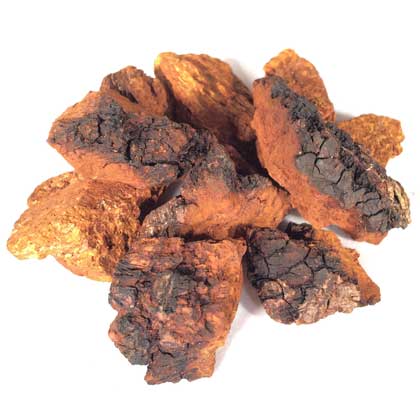
Preparing your own Chaga tea
We recommend a water-based extraction. Water-based extraction is a fancy way to say ‘make tea’. Most of the beneficial chemicals in Chaga will be released into this tea – but not all of them. To release all of the beneficial compounds, you will need to perform an alcohol extraction after making tea.
Here is a summary of how to make Chaga mushroom tea:
When you order raw chaga, it will arrive as chunks of thick mushroom mycelium.
- Break up your Chaga chunks into smaller pieces with a screwdriver and small hammer. Some people grind this material up further with a coffee grinder.
- Combine the Chaga with water. As far as volume is concerned, Allen Muskat suggests a reasonable water volume is about 1-2 times the amount you would use when making coffee. So, aim for about a 1/2 cup of Chaga for 2 quarts of water.
- Place the tea into a large pot or crock-pot and heat it up. You don’t want to bring the water to a boil. Water temperatures over 180°F can destroy some of the beneficial Chaga chemicals. The crock-pot is nice because it tells you the water temperature as it is heating up. Aim for 150°F. 150°F will extract the good stuff without breaking down their chemical structures.
- Allow the Chaga tea to simmer for 8 hours. This long simmer helps break down the tough matrix of chitin and polysaccharide molecules found in mushrooms. Once these tough molecules are broken down, they further release the biologically active chemicals locked within their matrix.
- Filter out the residual Chaga material after your simmer is finished.
- Store the tea and drink at your leisure.
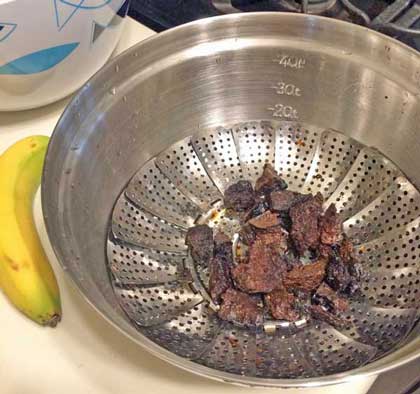
I measure out a 1/2 cup of Chaga chunks then combine with water in a bowl with quart measuring units.
Preparing your own Chaga tincture
If you want to be thorough, you can follow up this tea preparation with an alcohol based extraction. An alcohol based extraction is referred to as a ‘tincture’.
Some chemicals will not be released from the Chaga into the water-based Chaga tea. However, these chemicals will be released into an alcohol extraction. The reason for this has to with differences in chemical polarity. Without getting any deeper into extraction chemistry, suffice to say that an alcohol tincture will capture many of the biologically active chemicals that were not released into the tea. Here’s how I perform my alcohol-based Chaga extract.
- Collect the residual Chaga material from the emptied tea pot and move this into a glass jar. I use mason jars because of their tight fitting lids.
- Top off the jar with alcohol. You can use vodka or gin (40% alcohol). Sidenote: extraction of certain compounds require 100% alcohol for this step.
- Seal up this jar and allow this material to soak for a long time, up to 6 months. Keep the jars out of the sunlight. Sunlight can break down certain chemicals.
- Filter out the Chaga material. This alcohol tincture should remain potent for 1-2 years.
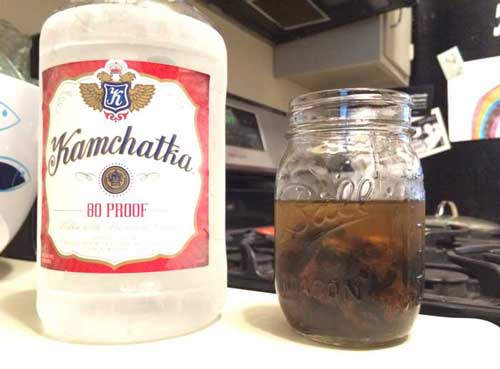
I use Russian vodka and mason jars for my alcohol-based Chaga extractions.
Chaga dosage
Chaga is a nutraceutical food, so there isn’t a strict dosage. However that said, many sources recommend 1 gram/day to serve as a general ‘health maintenance’ dosage. For reference, 1 gram of Chaga is about 1 teaspoon. If you are actively fighting an infection, try 1-2 grams/day for the duration of your infection.
Important disclaimer: When discussing dosage, it should be noted that no clinical trials have been performed to assess the safety of Chaga. As my disclaimer says at the bottom of the page, this website only serves as a general reference. The FDA has not reviewed the health claims associated with Chaga mushrooms.
That said, as far as I know, there is only 1 case of a health problem related to using Chaga mushrooms. A 72 year-old Japanese woman (with liver cancer) ingested 4-5 grams of Chaga powder every day for 6 months. This high dosage sustained for a long period of time eventually deposited oxalate crystals in her liver and contributed to renal failure (Kikuchi, 2014).
Chaga side effects: herb-drug interactions
If you use blood thinning medications, such as warfarin, take caution when using Chaga. One report shows that Chaga can inhibit platelet formation (Hyun, 2006). This effect could have a compounding effect if chaga is combined with blood thinning drugs.
If you use diabetes medication, take caution when using Chaga. An in vitro report suggests Chaga may lower blood sugar levels (Ying, 2014). This could have a compounding effect if combined with diabetes medication.
Chaga bio-availability
There is some debate on the bio-availability of Chaga nutrients in the human body. In summary, many of the biologically active chemicals in Chaga require a thorough extraction process to release these chemicals. The water/alcohol extraction method I describe above should do a very good job of releasing chemicals. For a more thorough extraction process, you can add heat to the alcohol step.
Once extracted, you may also be concerned that your body isn’t absorbing the full suite of Chaga chemicals. In this case, try adding some black pepper to your Chaga tea. Pepper helps stimulate the absorption of many compounds into the human body.
My recommendations for Chaga supplements. . .
Four Sigmatic Chaga Mushroom Elixir Tea
Brewing your own tea from raw chunks of Chaga is time consuming. It also takes practice to do correctly. If you simply want to drink Chaga tea and you don’t want to negotiate a 4-8 hour simmer on your stove-top, then order these Chaga tea packets.
Four Sigmatic Chaga tea is an excellent option. Each tea packet contains 1.5 grams of wild-crafted Siberian Chaga extract. This company is very thorough in their extraction process. They extract in both hot water and alcohol and standardize the final extraction to contain 30% polysaccharide and 2% triterpene content. This results in good bio-availability in the final spray-dried extract powder.
The Four Sigma company was founded in 2012 in Scandinavia by a collection of Nordic mushroom fanatics. The company has expanded quickly and is now located in 25 countries with their business headquarters in the U.S.
Their Chaga tea was first brought to my attention by a Tim Ferris podcast. In general, Tim is an intelligent and methodical guy. He mentioned this was his preference for Chaga – so I ordered some and I’m now a big fan.
Host Defense, Chaga Extract, 2 oz
Many people prefer to take their Chaga in a liquid, tincture form. This 2 ounce bottle contains about 60 servings. You can add a few drops to a smoothie or into your morning coffee.
As mentioned above, alcohol is an excellent solvent for extracting bio-active compounds from the Chaga. The alcohol concentration of this tincture is about 35%. The amount of alcohol that goes into your body from a few drops of this tincture won’t be noticeable, however if you’re a recovering alcoholic then perhaps even a few drops could be problematic. In that case, stick to the tea.
Host Defense has an excellent reputation within the mushroom community. This company was founded by Paul Staments and his wife, C. Dusty Yao. Paul Staments is a well-known expert in mushroom taxonomy and cultivation. When I was in college, I was a huge fan of Paul’s books on the cultivation of medicinal mushrooms.
The Host Defense company is situated in the temperate rain-forest region of Olympia, Washington – this is an ideal environment for mushroom growth. The company is a certified organic food producer and processor.
References
- https://www.mskcc.org/cancer-care/integrative-medicine/herbs/chaga-mushroom
- http://chaga-mushrooms.com/history-of-chaga/a-brief-history-of-chaga.html
- Fontana, Luigi, Linda Partridge, and Valter D. Longo. “Extending healthy life span—from yeast to humans.” science 328.5976 (2010): 321-326.
- Giridharan VV, Thandavarayan RA, Konishi T. Amelioration of scopolamine induced cognitive dysfunction and oxidative stress by Inonotus obliquus – a medicinal mushroom.Food Funct. Jun 2011;2(6):320-327.
- Glamočlija, Jasmina, et al. “Chemical characterization and biological activity of Chaga (Inonotus obliquus), a medicinal “mushroom”.” Journal of ethnopharmacology 162 (2015): 323-332.
- Hekimi, Siegfried, Jérôme Lapointe, and Yang Wen. “Taking a “good” look at free radicals in the aging process.” Trends in cell biology 21.10 (2011): 569-576.
- Hyun KW, Jeong SC, Lee DH, Park JS, Lee JS. Isolation and characterization of a novel platelet aggregation inhibitory peptide from the medicinal mushroom, Inonotus obliquus. Peptides. Jun 2006;27(6):1173-1178.
- Kang JH, Jang JE, Mishra SK, et al. Ergosterol peroxide from Chaga mushroom (Inonotus obliquus) exhibits anti-cancer activity by down-regulation of the beta-catenin pathway in colorectal cancer. J Ethnopharmacol. Sep 15 2015;173:303-312.
- Kikuchi Y, Seta K, Ogawa Y, et al. Chaga mushroom extract induced oxalate nephropathy. Clin Nephrol. Jun 2014;81(6):440-444.
- Kim, Yong Ook, et al. “Anti-cancer effect and structural characterization of endo-polysaccharide from cultivated mycelia of Inonotus obliquus.” Life Sciences 79.1 (2006): 72-80.
- Ko SK, Jin M, Pyo MY. Inonotus obliquus extracts suppress antigen-specific IgE production through the modulation of Th1/Th2 cytokines in ovalbumin-sensitized mice. J Ethnopharmacol. Oct 11 2011;137(3):1077-1082.
- Lee, Sung Hak, Hee Sun Hwang, and Jong Won Yun. “Antitumor activity of water extract of a mushroom, Inonotus obliquus, against HT‐29 human colon cancer cells.” Phytotherapy Research 23.12 (2009): 1784-1789.
- Mishra SK, Kang JH, Kim DK, et al. Orally administered aqueous extract of Inonotus obliquus ameliorates acute inflammation in dextran sulfate sodium (DSS)-induced colitis in mice. J Ethnopharmacol. Sep 28 2012;143(2):524-532.
- Najafzadeh M, Reynolds PD, Baumgartner A, Jerwood D, Anderson D. Chaga mushroom extract inhibits oxidative DNA damage in lymphocytes of patients with inflammatory bowel disease.Biofactors. 2007;31(3-4):191-200.
-
Ning, Xianbin, et al. “Inhibitory Effects of a Polysaccharide Extract from the Chaga tea Medicinal Mushroom, Inonotus obliquus (Higher Basidiomycetes), on the Proliferation of Human Neurogliocytoma Cells.” International journal of medicinal mushrooms 16.1 (2014).
- Park YM, Won JH, Kim YH, et al. In vivo and in vitro anti-inflammatory and anti-nociceptive effects of the methanol extract of Chaga tea benefits Inonotus obliquus. J Ethnopharmacol. Oct 3 2005;101(1-3):120-128.
- Saar, Maret. “Fungi in Khanty folk medicine.” Journal of Ethnopharmacology 31.2 (1991): 175-179.
- Softa, Mohamed, et al. “Birch Sap (Betula alba) and Chaga Mushroom (Inonotus obliquus) Extracts Show Anti-Oxidant, Anti-Inflammatory and DNA Protection/Repair Activity In Vitro.” (2019).
- Ying YM, Zhang LY, Zhang X, et al. Terpenoids with alpha-glucosidase inhibitory activity from the submerged culture of Inonotus obliquus. Phytochemistry. Dec 2014;108:171-176.
- Yue Z, Xiuhong Z, Shuyan Y, et al. Effect of Chaga mushroom tea Inonotus Obliquus Polysaccharides on physical fatigue in mice.J Tradit Chin Med. Aug 2015;35(4):468-472.
- Zhang, Lian‐Hui, and Yi‐Hu Dong. “Quorum sensing and signal interference: chaga benefits testimonials diverse implications.” Molecular microbiology 53.6 (2004): 1563-1571.
- Baek, Jiwon, et al. “Bioactivity-based analysis and chemical characterization of cytotoxic constituents from Chaga mushroom benefits (Inonotus obliquus) that induce apoptosis in human lung adenocarcinoma cells.” Journal of ethnopharmacology224 (2018): 63-75.
- Zhang, Sun-Dong, et al. “Inotodiol inhibits cells migration and invasion and induces apoptosis via p53-dependent pathway in HeLa cells.” Phytomedicine 60 (2019): 152957.
